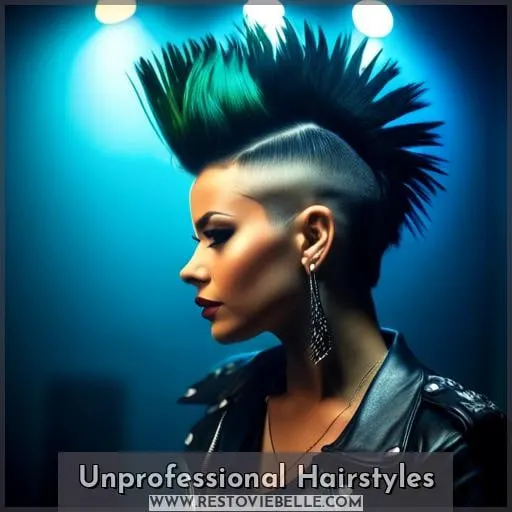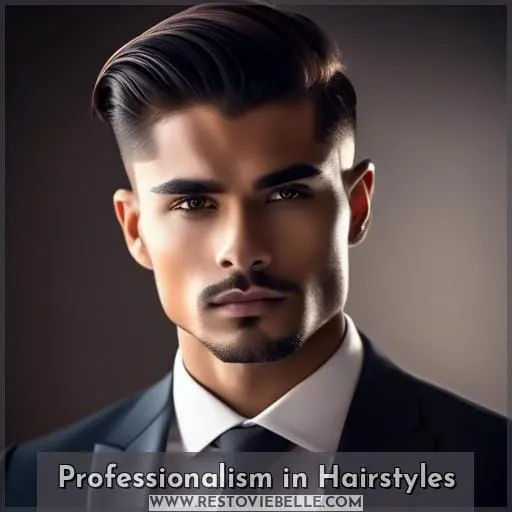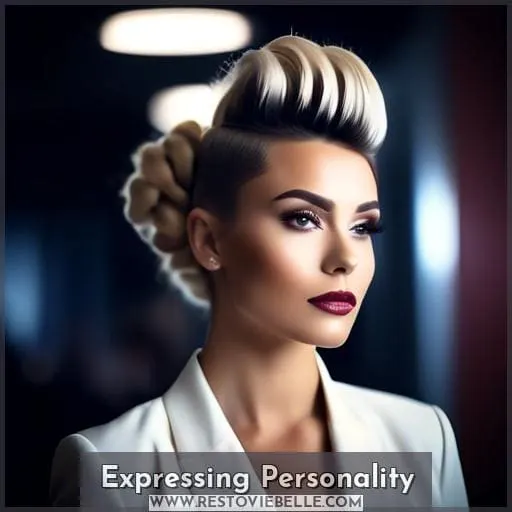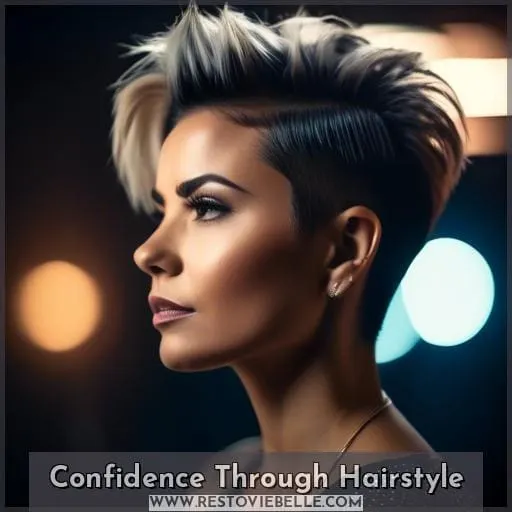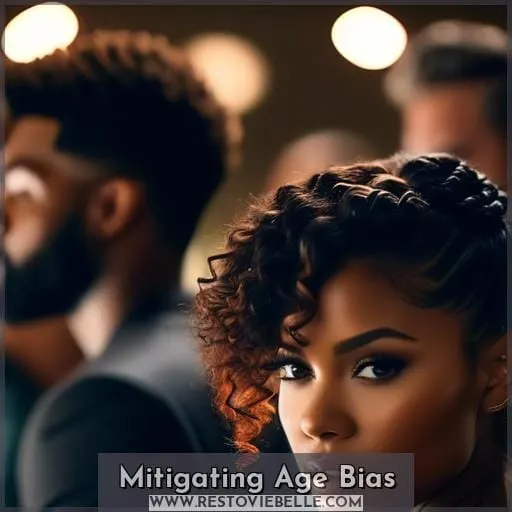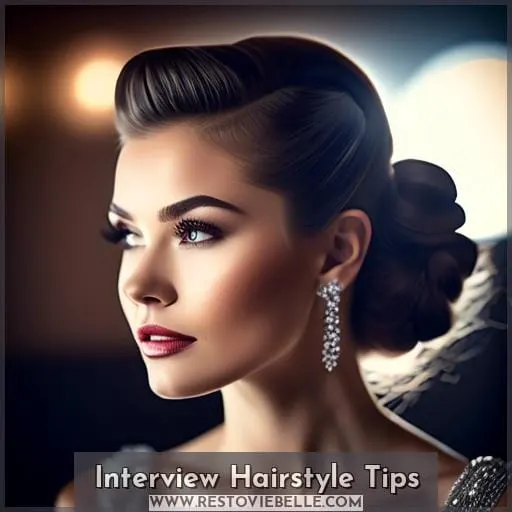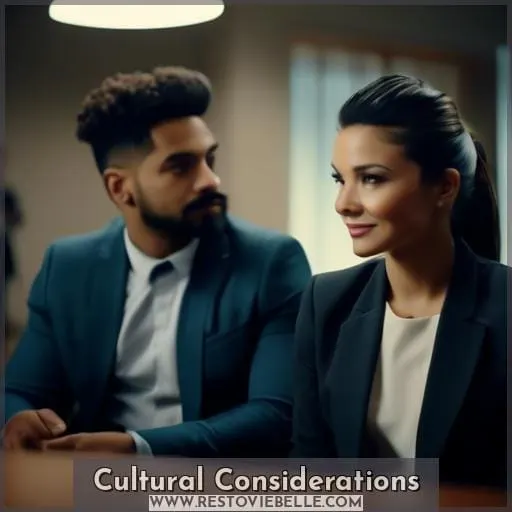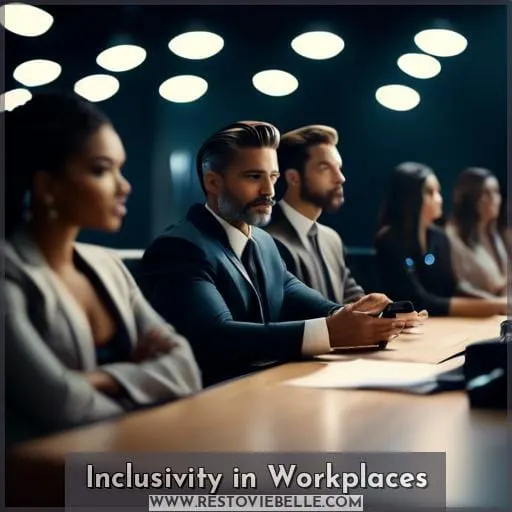This site is supported by our readers. We may earn a commission, at no cost to you, if you purchase through links.
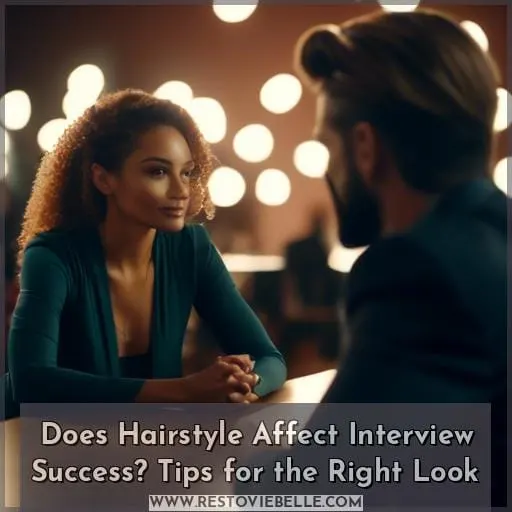 In today’s fiercely competitive job market, standing out in an interview is about more than just showcasing your skills and experience.
In today’s fiercely competitive job market, standing out in an interview is about more than just showcasing your skills and experience.
Interestingly, the way you style your hair could also play a pivotal role in making that crucial first impression. Whether you’re aiming for a sleek, professional look or considering a more creative hairstyle to express your personality, your choice can significantly influence how you’re perceived by potential employers.
This article delves into the impact of hairstyles on interview success, offering practical tips for choosing the right look that balances professionalism with personal expression. From understanding what constitutes an unprofessional hairstyle to boosting your confidence through your hairdo, we cover essential advice to help you navigate this often overlooked aspect of interview preparation.
Yes, hairstyle matters in an interview as it reflects your personality and professional attitude, influencing how you’re perceived by potential employers.
Table Of Contents
- Key Takeaways
- Unprofessional Hairstyles
- Professionalism in Hairstyles
- Expressing Personality
- Confidence Through Hairstyle
- Mitigating Age Bias
- Interview Hairstyle Tips
- Cultural Considerations
- Inclusivity in Workplaces
- Frequently Asked Questions (FAQs)
- How should I style my hair if I’m transitioning to a different hair texture or length and still want to look professional for an interview?
- Are there any specific hairstyles that can help to minimize attention to facial features I’m self-conscious about during an interview?
- What are the best practices for maintaining a professional hairstyle during a full day of multiple interviews or assessments?
- How can I ensure my hairstyle adheres to religious or cultural practices while still being viewed as professional in a Western corporate environment?
- Can the use of hair accessories be incorporated into a professional interview hairstyle without appearing too casual or distracting?
- Conclusion
Key Takeaways
A professional hairstyle can significantly impact an interviewer’s perception, reflecting the candidate’s professionalism, personality, and confidence. Unprofessional hairstyles, such as excessive height, colorful dyes, or unkempt looks, may negatively affect a candidate’s chances during an interview.
Expressing individuality through hairstyles can be beneficial, but it’s important to balance personal expression with the expectations of the job’s corporate culture. Workplaces are increasingly recognizing the importance of inclusivity and cultural awareness regarding hairstyles, which can influence interview and workplace policies.
Unprofessional Hairstyles
When preparing for a job interview, it’s crucial to consider how your hairstyle might be perceived.
Styles with excessive height, colorful dye jobs, dreadlocks, and braids can sometimes be viewed as unprofessional in certain work environments.
While you should feel comfortable and confident in your appearance, it’s also important to be aware of potential biases and choose a hairstyle that won’t distract from your qualifications and interview responses.
Excessive Height
Monitor excessive height.
- High ponytails appear juvenile.
- Extreme height and volume can distract.
- Height diminishes a professional image.
Stay moderate in volume and height to convey a polished, mature style that aligns with social norms.
Subtle lift with a low bun, high puff, or ponytail flatters without sacrificing professionalism.
Colorful Styles
Colorful hairstyles can indeed influence perceptions of professionalism in the workplace. While vibrant hair colors express personal identity and creativity, they may also clash with traditional professional standards.
In some environments, such styles might be seen as a distraction or even unprofessional, reflecting cultural biases and rigid professional perceptions. However, it’s essential to balance personal expression with the image you wish to project, especially in job interviews or conservative sectors.
Choosing a hairstyle or color should align with your comfort and confidence, contributing to personal growth without compromising professional opportunities. Hair accessories and subtle color variations can offer a compromise, allowing for personal expression while maintaining a professional appearance.
Dreadlocks and Braids
Continuing from the discussion on colorful styles, let’s delve into dreadlocks and braids. These hairstyles carry cultural significance and personal expression, yet they’re often unfairly tagged with unprofessional perceptions.
To navigate bias avoidance, consider updo options for locs and braids that maintain a polished look. While box braids may face scrutiny in some workplaces, they can also be a sophisticated choice that respects natural hair.
Professionalism in Hairstyles
When preparing for a job interview, it’s crucial to present a sophisticated look that demonstrates your attention to detail.
Your hairstyle should be neat and professional, as it can significantly influence the interviewer’s perception of you.
Opt for a style that aligns with the job you’re applying for, ensuring it projects a polished and professional attitude.
Sophisticated Look
When aiming for a sophisticated image in the workplace, your hairstyle plays a crucial role in your professional appearance.
-
Polished Look: A sleek and elegant chignon or a neatly styled low bun conveys a detail-oriented presentation. These styles aren’t only timeless but also reflect a sense of confidence and control.
-
Professional Attitude: Adhering to the dress code with a professional hairstyle, like a low bun or a chignon, demonstrates your respect for workplace norms and your commitment to maintaining a polished look.
-
Sophisticated Image: A sophisticated image is often associated with a sleek and elegant appearance. Opting for a professional hairstyle that’s well-groomed and understated can enhance this image, showing that you pay attention to the finer details of your presentation.
Attention to Detail
Building on the sophisticated look, paying attention to detail in your hairstyle for a job interview is crucial.
Dressing professionally and choosing the right hairstyle can significantly impact first impressions, which are often formed within seconds of meeting someone. Your hair is a key element of your personal branding, reflecting your professionalism and attention to detail.
It’s essential to consider cultural awareness and avoid bias in interviews by selecting styles that are polished yet authentic to you. Opting for a hairstyle that’s neat and well-maintained conveys a sense of responsibility and care, which can be as critical as the answers you provide to interview questions.
Whether you’re visiting a hair salon for a trim or styling your hair at home with quality styling products, ensure your appearance aligns with the job you’re applying for, enhancing your confidence and chances of success.
Expressing Personality
When preparing for a job interview, your hairstyle can be a canvas for personal expression. Opting for a creative and unique style can set you apart from other candidates, showcasing your individuality and self-assuredness.
It’s important to choose a hairstyle that not only reflects your personality but also maintains a professional appearance, ensuring you make a positive and memorable impression.
Creative Hairstyles
While professionalism in hairstyles is key, don’t shy away from creative expression that aligns with a professional image. Your personal style can make powerful first impressions, so consider hairstyles that are both unique and polished.
For instance, curly hair or waves can be a confidence booster when styled neatly. Two French braids into a bun or a low or high puff can offer a blend of creativity and sophistication. An easy messy bun, while relaxed, should still be tidy to maintain that professional edge.
Unique Style Showcase
Embracing your unique style isn’t just about standing out; it’s a powerful statement of personal expression and cultural diversity.
When you choose a hairstyle for your job interview, you’re not just preparing to answer questions; you’re showcasing a slice of your personality. This act of confidence building can significantly impact first impressions, setting a tone that resonates with your interviewer.
Whether it’s a low bun, a creative twist, or retwisted locs, selecting job interview hairstyles that reflect your essence while respecting the professional setting can enhance your confidence, making you feel prepared and ready to tackle any question with poise.
Confidence Through Hairstyle
Choosing the right hairstyle for an interview can significantly boost your confidence and ensure you feel prepared for the challenge ahead.
A hairstyle that makes you feel comfortable and confident can positively impact your behavior, tone, and body language during the interview.
It’s not just about looking good; it’s about feeling ready and self-assured, which can make a big difference in how you present yourself and respond to interview questions.
Self-Esteem Boost
Choosing the right hairstyle for a job interview can significantly boost your confidence, enhancing your overall presentation and potentially increasing your chances of interview success.
-
Reflects Professionalism: Opting for a hairstyle that aligns with the job you’re applying for, such as a sleek low bun or a classic French twist, conveys a professional attitude. Avoiding unprofessional styles like excessive height or colorful hairstyles can ensure you project the right image.
-
Boosts Self-Esteem: A well-chosen hairstyle can make you feel more confident and in control. This heightened self-esteem reflects in your behavior, tone, and body language, making you stand out positively during the interview.
-
Showcases Personality: While maintaining professionalism, your hairstyle can also express your creativity and unique style. Whether it’s a subtle pixie cut or soft waves, choosing a hairstyle that feels true to you can distinguish you from other applicants.
Preparedness
Choosing the right hairstyle for an interview can subtly enhance your preparedness, reflecting a meticulous and professional approach.
In San Mateo, a salon might suggest a low ponytail or a deva cut, but regardless of the style, it’s crucial to balance grooming standards with personal expression.
A hairstyle that meets expectations without compromising cultural awareness can boost your confidence, helping you tackle interview questions with poise.
Avoid extremes of unprofessional versus professional looks; instead, aim for a polished appearance that mitigates age bias and showcases your readiness for the role.
Mitigating Age Bias
In today’s competitive job market, your hairstyle can play a crucial role in mitigating age bias during interviews. Opting for a vibrant, well-maintained hairstyle can make older job seekers appear more alert and energetic, projecting an image of wisdom and experience that can be highly valued by employers.
This strategic choice not only helps in reducing the impact of age discrimination but also demonstrates a positive and youthful attitude, essential for making a strong first impression.
Vibrant Look for Older Job Seekers
As you navigate the job market, consider how vibrant hairstyles can enhance your professional image and counteract age discrimination.
- Choose styles that add volume and frame your face, projecting vitality and confidence.
- Opt for modern cuts that reflect experience without dating your look.
- Consider subtle color enhancements to convey a polished, yet youthful presence.
- Avoid overly trendy styles that might overshadow your professional qualifications.
Embrace a hairstyle that makes you feel empowered, balancing personal expression with a professional demeanor. This approach can be a strategic move to diminish the impact of age bias and ensure your skills and experience take center stage.
Wisdom and Experience Projection
Choosing a hairstyle that projects wisdom and experience can significantly mitigate age bias during job interviews. Opting for a look that balances professionalism with self-expression can make a powerful first impression, demonstrating not only your expertise but also your awareness of cultural sensitivity.
This approach not only combats age discrimination but also aligns with your professional image, ensuring you’re seen as a vibrant, confident candidate. Remember, your hairstyle is an extension of your identity; it should enhance your confidence and convey the depth of your experience, making you unforgettable from the moment you walk in.
Interview Hairstyle Tips
When preparing for an interview, consider opting for low maintenance styles or classic updos and buns. These hairstyles are practical and convey a polished, professional image, which can help you make a positive impression.
Remember to practice your chosen hairstyle beforehand to ensure it looks neat and you feel comfortable during the interview.
Low Maintenance Styles
Transitioning from mitigating age bias to discussing low maintenance styles, it’s crucial to remember that your hairstyle can significantly impact your interview success. Opting for a style that’s both professional and easy to manage can enhance your confidence without detracting from your qualifications.
- Choose styles that require minimal upkeep, allowing you to focus on the interview.
- Consider natural hair or protective styles to maintain scalp health.
- Use quality hair products to ensure your hair looks polished without excessive effort.
- Avoid hair extensions that might require frequent adjustments, keeping your appearance neat and distraction-free.
These tips bridge the gap between presenting a vibrant, professional image and ensuring your hairstyle remains practical and comfortable throughout the interview process.
Updos and Buns
Continuing from the practicality of low-maintenance styles, let’s delve into the polished world of updos and buns. These styles not only keep your hair neatly away from your face but also exude sophistication.
Whether you’re aiming for a formal updo or a casual messy bun, the variations are endless and can be tailored to your personal taste and the requirements of the occasion.
Here’s a quick guide to help you choose:
| Updo Variations | Bun Variations | When to Wear |
|---|---|---|
| Formal updos | Elegant buns | Interviews, formal events |
| Messy buns | Messy buns | Casual meetings, creative spaces |
| Creative twists | Formal buns | Networking events, presentations |
Cultural Considerations
When considering hairstyles for job interviews, it’s important to recognize the cultural significance and varying perceptions of styles like box braids.
While some may view them as unprofessional, they hold deep cultural importance for many individuals.
Your choice in hairstyle should reflect both your personal comfort and the cultural awareness of the potential employer.
Keeping in mind that biases, although diminishing, still exist in the workplace.
Box Braids Perception
When considering box braids for an interview, it’s crucial to understand the varying perceptions that exist. While some view them as a celebration of cultural identity, others may hold biases, consciously or unconsciously, that affect their professional judgment.
- Cultural Awareness: Recognize that box braids carry cultural significance and history.
- Perception: Be aware that in some professional settings, box braids may be misunderstood or unfairly judged.
- Bias: Acknowledge the potential for bias and its impact on interview success.
- Inclusivity: Aim for workplaces that value inclusivity and respect for cultural expressions.
Cultural Significance
Understanding the cultural significance of hairstyles is crucial in today’s diverse workplace. Your hairstyle isn’t just a personal choice; it’s a reflection of your identity, heritage, and the cultural legacy you carry.
This understanding is essential for fostering diversity and inclusion, combating unconscious bias, and promoting workplace equity. Unfortunately, hair discrimination remains a pervasive issue, affecting not only personal expression but also professional opportunities.
Here’s a quick overview to help you navigate the complex landscape of cultural considerations in hairstyles:
| Aspect | Importance |
|---|---|
| Cultural Awareness | Recognizing the deep-rooted cultural significance of hairstyles like dreadlocks, braids, and afros can foster a more inclusive environment. |
| Diversity and Inclusion | Embracing diverse hairstyles demonstrates a commitment to inclusivity, reflecting a company’s values towards diversity. |
| Unconscious Bias | Awareness of one’s unconscious biases towards certain hairstyles can mitigate discriminatory practices and decisions. |
| Workplace Equity | Equitable treatment of all hairstyles ensures that employees feel respected and valued, regardless of their cultural background. |
| Hair Discrimination | Understanding and addressing hair discrimination is crucial for creating a respectful and open workplace for everyone. |
Incorporating these considerations into workplace policies and practices not only combats hair discrimination but also enhances the overall sense of belonging and acceptance among employees. It’s about respecting and valuing the cultural significance behind each hairstyle, recognizing it as an integral part of one’s identity and heritage.
Inclusivity in Workplaces
Transitioning from the importance of cultural sensitivity and the perception of box braids in the workplace, it’s crucial to address the broader theme of inclusivity in workplaces.
In today’s diverse work environment, understanding and mitigating unconscious bias, ethnic discrimination, and hair discrimination is paramount. Societal expectations often dictate a narrow view of professionalism, inadvertently promoting cultural insensitivity.
This not only stifles individual expression but also perpetuates systemic barriers for those with hairstyles deeply rooted in their cultural identity.
To foster a truly inclusive workplace, organizations must challenge these outdated norms by embracing a wide array of hairstyles and recognizing their cultural significance. Doing so not only respects individual identity but also enriches the workplace culture, encouraging everyone to bring their whole selves to work.
This approach not only combats hair discrimination but also addresses broader issues of unconscious bias and ethnic discrimination, paving the way for a more equitable and understanding work environment.
Frequently Asked Questions (FAQs)
How should I style my hair if I’m transitioning to a different hair texture or length and still want to look professional for an interview?
Opt for a sleek, low bun or a polished ponytail to maintain a professional look while transitioning hair textures or lengths.
These styles are versatile and convey confidence without distracting from your qualifications.
Are there any specific hairstyles that can help to minimize attention to facial features I’m self-conscious about during an interview?
Opt for hairstyles that balance facial features you’re self-conscious about.
For a heart-shaped face, consider a pixie cut.
For a rounder face, opt for soft waves.
What are the best practices for maintaining a professional hairstyle during a full day of multiple interviews or assessments?
Imagine stepping into a room, your hair styled in a low ponytail or a sleek bun, exuding confidence and control.
For a full day of interviews, choose a hairstyle that’s both elegant and practical, ensuring it stays neat with quality hair products.
This polished look will keep you focused and poised, ready to conquer each meeting with assurance.
How can I ensure my hairstyle adheres to religious or cultural practices while still being viewed as professional in a Western corporate environment?
Choosing a hairstyle that respects your religious or cultural practices is essential. It not only reflects your identity but also demonstrates your commitment to your beliefs. When communicating the importance of this choice to your employer, emphasize how it aligns with your values and traditions.
Ensure that your hairstyle is neat and complies with the company’s professional standards to maintain a polished appearance in the workplace.
Can the use of hair accessories be incorporated into a professional interview hairstyle without appearing too casual or distracting?
Yes, incorporating hair accessories into a professional interview hairstyle can enhance your look without appearing too casual or distracting.
Opt for subtle, elegant pieces like a sleek ponytail holder or a minimalist barrette that complements your outfit. This approach keeps your style polished and focused, boosting your confidence and professionalism.
Conclusion
Imagine stepping into the interview room, your confidence buoyed not just by your impeccable resume and polished skills, but also by the way your hair perfectly frames your face, striking the right balance between professionalism and personal expression.
Yes, the question of whether hairstyle matters in an interview finds its answer not just in the affirmative but in the nuanced understanding that your hair can indeed be a silent yet powerful communicator of your identity, professionalism, and attention to detail.
From avoiding excessively high or overly colorful styles to embracing sophisticated looks that boost your self-esteem, the right hairstyle can mitigate age bias, respect cultural considerations, and even enhance inclusivity in workplaces.
So, as you prepare for your next big opportunity, remember that your choice of hairstyle isn’t just about aesthetics; it’s about making a statement of who you are and what you bring to the table, ensuring you leave a lasting impression that goes beyond the first handshake.
